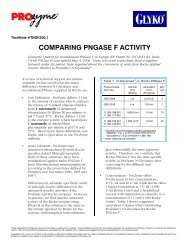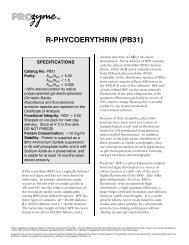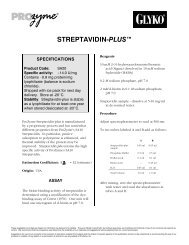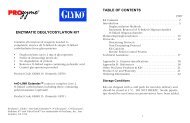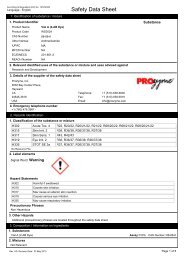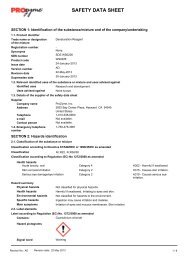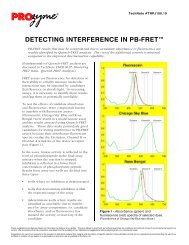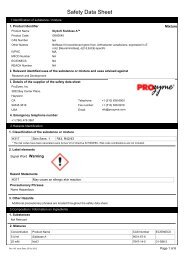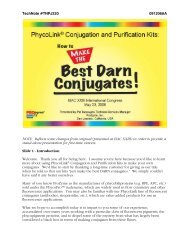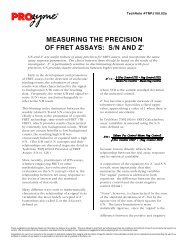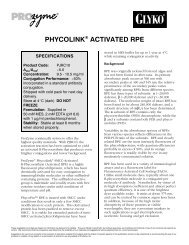SAFETY DATA SHEET - ProZyme
SAFETY DATA SHEET - ProZyme
SAFETY DATA SHEET - ProZyme
You also want an ePaper? Increase the reach of your titles
YUMPU automatically turns print PDFs into web optimized ePapers that Google loves.
<strong>SAFETY</strong> <strong>DATA</strong> <strong>SHEET</strong><br />
SECTION 1: Identification of the substance/mixture and of the company/undertaking<br />
1.1. Product identifier<br />
Trade name or designation<br />
of the mixture<br />
Registration number<br />
Synonyms<br />
SDS number<br />
Product code<br />
Issue date<br />
Version number<br />
Revision date -<br />
Supersedes date<br />
PHYCOLINK ® STREPTAVIDIN-ALLOPHYCOCYANIN<br />
-<br />
Streptavidin-APC<br />
SDS PJ25S<br />
PJ25S<br />
15-September-2013<br />
AC<br />
02-September-2009<br />
1.2. Relevant identified uses of the substance or mixture and uses advised against<br />
Identified uses<br />
Research and development.<br />
Uses advised against<br />
None known.<br />
1.3. Details of the supplier of the safety data sheet<br />
Supplier<br />
Company name<br />
Address<br />
Division<br />
<strong>ProZyme</strong>, Inc.<br />
3832 Bay Center Place<br />
Hayward, CA 94545<br />
Telephone 1-510-638-6900<br />
e-mail<br />
Not available.<br />
Contact person<br />
Not available.<br />
1.4. Emergency telephone<br />
number<br />
1-760-476-3961<br />
SECTION 2: Hazards identification<br />
2.1. Classification of the substance or mixture<br />
Classification according to Directive 67/548/EEC or 1999/45/EC as amended<br />
This preparation does not meet the criteria for classification according to Directive 1999/45/EC as amended.<br />
Classification according to Regulation (EC) No 1272/2008 as amended<br />
This mixture does not meet the criteria for classification according to Regulation (EC) 1272/2008 as amended.<br />
Hazard summary<br />
Physical hazards<br />
Health hazards<br />
Environmental hazards<br />
Specific hazards<br />
Main symptoms<br />
2.2. Label elements<br />
Not classified for physical hazards.<br />
Not classified for health hazards.<br />
Not classified for hazards to the environment.<br />
Direct contact with eyes may cause temporary irritation. Prolonged or repeated contact may dry<br />
skin and cause irritation.<br />
Irritant effects.<br />
Label according to Regulation (EC) No. 1272/2008 as amended<br />
Contains:<br />
Streptavid in-Al lophy cocyanin Conjugate<br />
Hazard pictograms<br />
Signal word<br />
Hazard statements<br />
Precautionary statements<br />
Prevention<br />
Response<br />
Storage<br />
None.<br />
None.<br />
The mixture does not meet the criteria for classification.<br />
Observe good industrial hygiene practices.<br />
Wash hands after handling.<br />
Store away from incompatible materials.<br />
PHYCOLINK STREPTAVIDIN-ALLOPHYCOCYANIN<br />
SDS EU<br />
915413 Version No.: AC Revision date: - Issue date: 15-September-2013 1 / 6
Disposal<br />
Dispose of waste and residues in accordance with local authority requirements.<br />
Supplemental label information Not applicable.<br />
2.3. Other hazards Not a PBT or vPvB substance or mixture.<br />
SECTION 3: Composition/information on ingredients<br />
3.2. Mixtures<br />
General information<br />
Chemical name<br />
% CAS-No. / EC No. REACH Registration No. INDEX No.<br />
Notes<br />
Streptavidin-Allophy cocyanin<br />
Conjugate<br />
Classification: DSD: -<br />
< 0,5<br />
N/A<br />
-<br />
-<br />
-<br />
CLP:<br />
-<br />
CLP: Regulation No. 1272/2008.<br />
DSD: Directive 67/548/EEC.<br />
SECTION 4: First aid measures<br />
General information<br />
Ensure that medical personnel are aware of the material(s) involved, and take precautions to<br />
protect themselves.<br />
4.1. Description of first aid measures<br />
Inhalation<br />
Move to fresh air. Call a physician if symptoms develop or persist.<br />
Skin contact<br />
Eye contact<br />
Ingestion<br />
4.2. Most important symptoms<br />
and effects, both acute and<br />
delayed<br />
4.3. Indication of any<br />
immediate medical attention<br />
and special treatment needed<br />
Wash skin with soap and water. Get medical attention if irritation develops and persists.<br />
Rinse with water. Get medical attention if irritation develops and persists.<br />
Rinse mouth. Get medical attention if symptoms occur.<br />
Irritant effects.<br />
SECTION 5: Firefighting measures<br />
General fire hazards<br />
5.1. Extinguishing media<br />
Suitable extinguishing<br />
media<br />
Unsuitable extinguishing<br />
media<br />
5.2. Special hazards arising<br />
from the substance or mixture<br />
5.3. Advice for firefighters<br />
Special protective<br />
equipment for firefighters<br />
Special fire fighting<br />
procedures<br />
Treat symptomatically.<br />
This product is not flammable.<br />
Water fog. Foam. Dry chemical powder. Carbon dioxide (CO2).<br />
None known.<br />
SECTION 6: Accidental release measures<br />
During fire, gases hazardous to health may be formed.<br />
Self-contained breathing apparatus and full protective clothing must be worn in case of fire.<br />
In case of fire and/or explosion do not breathe fumes. Move containers from fire area if you can do<br />
so without risk.<br />
6.1. Personal precautions, protective equipment and emergency procedures<br />
For non-emergency Keep unnecessary personnel away. Wear appropriate protective equipment and clothing during<br />
personnel<br />
clean-up.<br />
For emergency responders<br />
Keep unnecessary personnel away. Use personal protection recommended in Section 8 of the<br />
SDS.<br />
6.2. Environmental precautions Avoid discharge into drains, water courses or onto the ground.<br />
6.3. Methods and material for<br />
containment and cleaning up<br />
Large Spills: Dike the spilled material, where this is possible. Absorb in vermiculite, dry sand or<br />
earth and place into containers. Following product recovery, flush area with water.<br />
Small Spills: Wipe up with absorbent material (e.g. cloth, fleece). Clean surface thoroughly to<br />
remove residual contamination.<br />
Never return spills in original containers for re-use.<br />
PHYCOLINK STREPTAVIDIN-ALLOPHYCOCYANIN<br />
SDS EU<br />
915413 Version No.: AC Revision date: - Issue date: 15-September-2013 2 / 6
6.4. Reference to other<br />
sections<br />
For personal protection, see section 8. For waste disposal, see section 13.<br />
SECTION 7: Handling and storage<br />
7.1. Precautions for safe<br />
handling<br />
7.2. Conditions for safe<br />
storage, including any<br />
incompatibilities<br />
7.3. Specific end use(s) Research and development.<br />
SECTION 8: Exposure controls/personal protection<br />
8.1. Control parameters<br />
Occupational exposure limits<br />
Avoid contact with eyes, skin, and clothing. Wear appropriate personal protective equipment.<br />
Observe good industrial hygiene practices.<br />
Keep container tightly closed. Store at 2-8°C (35-46°F). Protect from light. Do not freeze. Store<br />
away from incompatible materials.<br />
Latvia. OELs. Occupational exposure limit values of chemical substances in work environment<br />
Components<br />
Sodium chloride (CAS<br />
7647-14-5)<br />
Type<br />
TWA<br />
Value<br />
5 mg/m3<br />
Lithuania. OELs. Limit Values for Chemical Substances, General Requirements (Hygiene Norm HN 23:2007)<br />
Components<br />
Sodium chloride (CAS<br />
7647-14-5)<br />
Biological limit values<br />
Recommended monitoring<br />
procedures<br />
Derived no-effect level (DNEL)<br />
Predicted no effect<br />
concentrations (PNECs)<br />
Type<br />
Value<br />
TWA<br />
5 mg/m3<br />
No biological exposure limits noted for the ingredient(s).<br />
Follow standard monitoring procedures.<br />
Not available.<br />
Not available.<br />
8.2. Exposure controls<br />
Appropriate engineering<br />
controls<br />
Good general ventilation (typically 10 air changes per hour) should be used. Ventilation rates<br />
should be matched to conditions. If applicable, use process enclosures, local exhaust ventilation,<br />
or other engineering controls to maintain airborne levels below recommended exposure limits. If<br />
exposure limits have not been established, maintain airborne levels to an acceptable level. Eye<br />
wash facilities and emergency shower must be available when handling this product.<br />
Individual protection measures, such as personal protective equipment<br />
General information Use personal protective equipment as required. Personal protection equipment should be chosen<br />
according to the CEN standards and in discussion with the supplier of the personal protective<br />
equipment.<br />
Eye/face protection<br />
Skin protection<br />
- Hand protection Wear protective gloves.<br />
If contact is likely, safety glasses with side shields are recommended.<br />
- Other Wear suitable protective clothing.<br />
Respiratory protection<br />
Thermal hazards<br />
Hygiene measures<br />
Environmental exposure<br />
controls<br />
SECTION 9: Physical and chemical properties<br />
9.1. Information on basic physical and chemical properties<br />
Appearance<br />
Odour<br />
Physical state<br />
Form<br />
Colour<br />
Odour threshold<br />
In case of insufficient ventilation, wear suitable respiratory equipment.<br />
Wear appropriate thermal protective clothing, when necessary.<br />
Always observe good personal hygiene measures, such as washing after handling the material<br />
and before eating, drinking, and/or smoking. Routinely wash work clothing and protective<br />
equipment to remove contaminants.<br />
Environmental manager must be informed of all major releases.<br />
Liquid.<br />
Liquid.<br />
Blue<br />
Not available.<br />
Not available.<br />
PHYCOLINK STREPTAVIDIN-ALLOPHYCOCYANIN<br />
SDS EU<br />
915413 Version No.: AC Revision date: - Issue date: 15-September-2013 3 / 6
pH 8,2<br />
Melting point/freezing point<br />
Initial boiling point and boiling<br />
range<br />
Flash point<br />
Evaporation rate<br />
Not available.<br />
Not available.<br />
Not available.<br />
Not available.<br />
Flammability (solid, gas)<br />
Not available.<br />
Upper/lower flammability or explosive limits<br />
Flammability limit - lower Not available.<br />
(%)<br />
Flammability limit - upper<br />
(%)<br />
Vapour pressure<br />
Not available.<br />
Not available.<br />
Vapour density<br />
Relative density<br />
Solubility(ies)<br />
Partition coefficient<br />
(n-octanol/water)<br />
Auto-ignition temperature<br />
Decomposition temperature<br />
Viscosity<br />
Not available.<br />
Not available.<br />
Not available.<br />
Not available.<br />
Not available.<br />
Not available.<br />
Not available.<br />
Explosive properties<br />
Oxidizing properties<br />
Not available.<br />
Not available.<br />
9.2. Other information No relevant additional information available.<br />
SECTION 10: Stability and reactivity<br />
10.1. Reactivity The product is stable and non-reactive under normal conditions of use, storage and transport.<br />
10.2. Chemical stability Material is stable under normal conditions.<br />
10.3. Possibility of hazardous<br />
reactions<br />
No dangerous reaction known under conditions of normal use.<br />
10.4. Conditions to avoid Excessive heat. Contact with incompatible materials.<br />
10.5. Incompatible materials Strong oxidising agents.<br />
10.6. Hazardous<br />
decomposition products<br />
SECTION 11: Toxicological information<br />
No hazardous decomposition products are known.<br />
General information<br />
Low hazard for usual industrial or commercial handling by trained personnel.<br />
Information on likely routes of exposure<br />
Ingestion<br />
Expected to be a low ingestion hazard.<br />
Inhalation<br />
No adverse effects due to inhalation are expected.<br />
Skin contact<br />
Prolonged or repeated contact may dry skin and cause irritation.<br />
Eye contact<br />
Direct contact with eyes may cause temporary irritation.<br />
Symptoms<br />
Irritant effects.<br />
11.1. Information on toxicological effects<br />
Acute toxicity<br />
Skin corrosion/irritation<br />
Serious eye damage/eye<br />
irritation<br />
Respiratory sensitisation<br />
Skin sensitisation<br />
Germ cell mutagenicity<br />
Carcinogenicity<br />
Reproductive toxicity<br />
Based on available data, the classification criteria are not met.<br />
Based on available data, the classification criteria are not met.<br />
Based on available data, the classification criteria are not met.<br />
Based on available data, the classification criteria are not met.<br />
Based on available data, the classification criteria are not met.<br />
Based on available data, the classification criteria are not met.<br />
Based on available data, the classification criteria are not met.<br />
Based on available data, the classification criteria are not met.<br />
PHYCOLINK STREPTAVIDIN-ALLOPHYCOCYANIN<br />
SDS EU<br />
915413 Version No.: AC Revision date: - Issue date: 15-September-2013 4 / 6
Specific target organ toxicity -<br />
single exposure<br />
Specific target organ toxicity -<br />
repeated exposure<br />
Aspiration hazard<br />
Mixture versus substance<br />
information<br />
Other information<br />
Based on available data, the classification criteria are not met.<br />
Based on available data, the classification criteria are not met.<br />
Due to lack of data the classification is not possible.<br />
Not available.<br />
Not available.<br />
SECTION 12: Ecological information<br />
12.1. Toxicity The product components are not classified as environmentally hazardous. However, this does not<br />
exclude the possibility that large or frequent spills can have a harmful or damaging effect on the<br />
environment.<br />
12.2. Persistence and<br />
degradability<br />
12.3. Bioaccumulative potential Not available.<br />
Bioconcentration factor (BCF)<br />
No data is available on the degradability of this product.<br />
Not available.<br />
12.4. Mobility in soil Not available.<br />
12.5. Results of PBT<br />
and vPvB<br />
assessment<br />
Not a PBT or vPvB substance or mixture.<br />
12.6. Other adverse effects No other adverse environmental effects (e.g. ozone depletion, photochemical ozone creation<br />
potential, endocrine disruption, global warming potential) are expected from this component.<br />
SECTION 13: Disposal considerations<br />
13.1. Waste treatment methods<br />
Residual waste<br />
Contaminated packaging<br />
EU waste code<br />
Disposal methods/information<br />
Special precautions<br />
Dispose of in accordance with local regulations. Empty containers or liners may retain some<br />
product residues. This material and its container must be disposed of in a safe manner (see:<br />
Disposal instructions).<br />
Since emptied containers may retain product residue, follow label warnings even after container is<br />
emptied.<br />
The Waste code should be assigned in discussion between the user, the producer and the waste<br />
disposal company.<br />
Collect and reclaim or dispose in sealed containers at licensed waste disposal site.<br />
Dispose in accordance with all applicable regulations.<br />
SECTION 14: Transport information<br />
ADR<br />
Not regulated as dangerous goods.<br />
RID<br />
Not regulated as dangerous goods.<br />
ADN<br />
Not regulated as dangerous goods.<br />
IATA<br />
Not regulated as dangerous goods.<br />
IMDG<br />
Not regulated as dangerous goods.<br />
14.7. Transport in bulk<br />
according to Annex II of<br />
MARPOL 73/78 and the IBC<br />
Code<br />
SECTION 15: Regulatory information<br />
This substance/mixture is not intended to be transported in bulk.<br />
15.1. Safety, health and environmental regulations/legislation specific for the substance or mixture<br />
EU regulations<br />
Regulation (EC) No. 1005/2009 on substances that deplete the ozone layer, Annex I<br />
Not listed.<br />
Regulation (EC) No. 1005/2009 on substances that deplete the ozone layer, Annex II<br />
Not listed.<br />
Regulation (EC) No. 850/2004 On persistent organic pollutants, Annex I as amended<br />
Not listed.<br />
PHYCOLINK STREPTAVIDIN-ALLOPHYCOCYANIN<br />
SDS EU<br />
915413 Version No.: AC Revision date: - Issue date: 15-September-2013 5 / 6
Regulation (EC) No. 689/2008 concerning the export and import of dangerous chemicals, Annex I, part 1 as amended<br />
Not listed.<br />
Regulation (EC) No. 689/2008 concerning the export and import of dangerous chemicals, Annex I, part 2 as amended<br />
Not listed.<br />
Regulation (EC) No. 689/2008 concerning the export and import of dangerous chemicals, Annex I, part 3 as amended<br />
Not listed.<br />
Regulation (EC) No. 689/2008 concerning the export and import of dangerous chemicals, Annex V as amended<br />
Not listed.<br />
Regulation (EC) No. 166/2006 Annex II Pollutant Release and Transfer Registry<br />
Not listed.<br />
Regulation (EC) No. 1907/2006, REACH Article 59(1) Candidate List as currently published by ECHA<br />
Not listed.<br />
Authorisations<br />
Regulation (EC) No. 1907/2006, REACH Annex XIV Substances subject to authorisation, as amended<br />
Not listed.<br />
Restrictions on use<br />
Regulation (EC) No. 1907/2006, REACH Annex XVII Substances subject to restriction on marketing and use as amended<br />
Not listed.<br />
Directive 2004/37/EC: on the protection of workers from the risks related to exposure to carcinogens and mutagens at<br />
work<br />
Not regulated.<br />
Directive 92/85/EEC: on the safety and health of pregnant workers and workers who have recently given birth or are<br />
breastfeeding<br />
Not regulated.<br />
Other EU regulations<br />
Directive 96/82/EC (Seveso II) on the control of major-accident hazards involving dangerous substances<br />
Not regulated.<br />
Directive 98/24/EC on the protection of the health and safety of workers from the risks related to chemical agents at work<br />
Not listed.<br />
Directive 94/33/EC on the protection of young people at work<br />
Not listed.<br />
Other regulations<br />
National regulations<br />
15.2. Chemical safety<br />
assessment<br />
SECTION 16: Other information<br />
The product is classified and labelled in accordance with EC directives or respective national laws.<br />
This Safety Data Sheet complies with the requirements of Regulation (EC) No 1907/2006.<br />
Not available.<br />
No Chemical Safety Assessment has been carried out.<br />
List of abbreviations<br />
References<br />
Information on evaluation<br />
method leading to the<br />
classification of mixture<br />
Full text of any statements or<br />
R-phrases and H-statements<br />
under Sections 2 to 15<br />
Training information<br />
Disclaimer<br />
Trademarks<br />
TWA: Time weighted average.<br />
Not available.<br />
The classification for health and environmental hazards is derived by a combination of calculation<br />
methods and test data, if available.<br />
None.<br />
Follow training instructions when handling this material.<br />
The information in this (M)SDS was obtained from sources which we believe are reliable but<br />
cannot guarantee. Additionally, your use of this information is beyond our control and may be<br />
beyond our knowledge. Therefore, the information is provided without any representation or<br />
warranty express or implied.<br />
<strong>ProZyme</strong> and PhycoLink are trademarks or registered trademarks in the United States and other<br />
countries.<br />
PHYCOLINK STREPTAVIDIN-ALLOPHYCOCYANIN<br />
SDS EU<br />
915413 Version No.: AC Revision date: - Issue date: 15-September-2013 6 / 6



